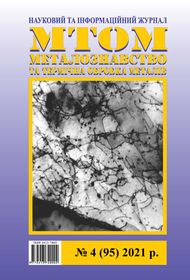MATHEMATICAL MODELING OF HARDNESS OF CAST IRON ROLLS PERFORMANCE ЛПХ17НМдц
DOI:
https://doi.org/10.30838/J.PMHTM.2413.281221.64.825Keywords:
rolls ЛПХ17НМдц; chemical composition; hardness; heat treatment; carbides; modelAbstract
Introduction. The technology of manufacturing sheet rolls is complex. The formation of their working layer is influenced by many parameters due to the standard technology of their manufacture. The service properties of rolls and quality of rolled metal largely depend on it. Heat treatment (annealing) is used to improve the properties of the rolls and to minimize residual stresses. Therefore, the study of the impact of heat treatment on the quality of cast iron sheet rolls using non-destructive methods is an urgent task of the metallurgical industry. Materials and methods. The influence of heat treatment on the hardness of cast iron rolls of ЛПХ17НМдц in the working layer (from 0 to 160 mm) was studied. The hardness values in the working layer of the rolls before heat treatment ranged from 47 to 49 HSD. After heat treatment, the hardness values increased significantly and varied from 72 to 75 HSD, which meets the requirements of ТУ У 14-2-1188-97. The metal matrix of the lower treph of the roll before heat treatment consisted of perlite cast iron microalloyed with chromium and nickel, consisting of perlite (81… 85 %), cementite (12…16 %), spherical graphite (2…3 %). After heat treatment, the structure of the bottom of the roll barrel was as follows: Chromium carbides + sorbitol tempering + Austenite ~ 7 %. The results of the experiment. At the initial stage of research with the use of expert evaluation, the analysis of the influence of the chemical composition of the rolls on their mechanical properties was performed using the developed author's software product (Yu.I. Dubrov, V.M. Volchuk, F.V. Kriulin). This is an important stage of research, because the size of the rolls and their chemical composition largely depends on the choice of heat treatment modes. Mathematical models are obtained by comparing the values of hardness at the reference points of the working layer of the roll barrel and the distance from the barrel surface. Mathematical models describe the effect of heat treatment on the hardness of the working layer and have satisfactory correlation coefficients R² = 0,72 (before heat treatment) and R² = 0,87 (after heat treatment). Conclusions. The change in the hardness of the rolls in the working layer before and after heat treatment, which is described by mathematical models using expert estimates, has been studied.

Downloads
Published
Issue
Section
License
Authors that are published in this journal agree to follow the conditions:
Authors reserve the right to the authorship of his work and cede the right to the journal of first publication of this work on conditions of the license under the Creative Commons Attribution License, which allows others to distribute it freely with the obligatory reference to the author of the original work and the first publication of the work in this journal.
